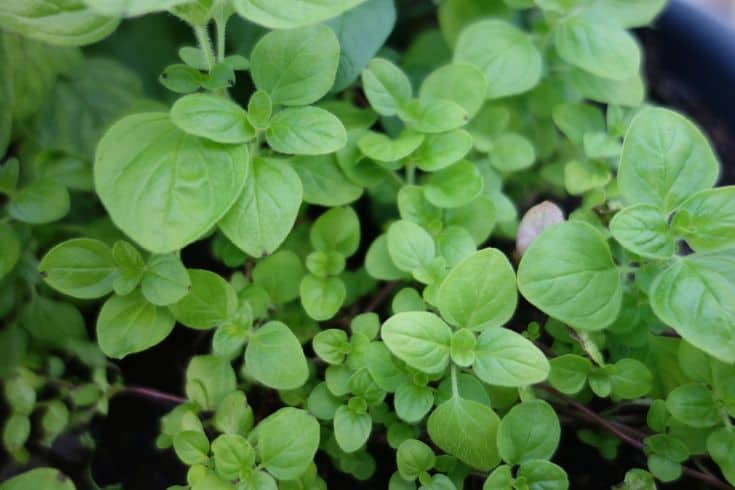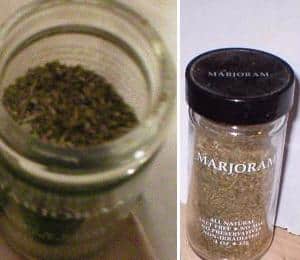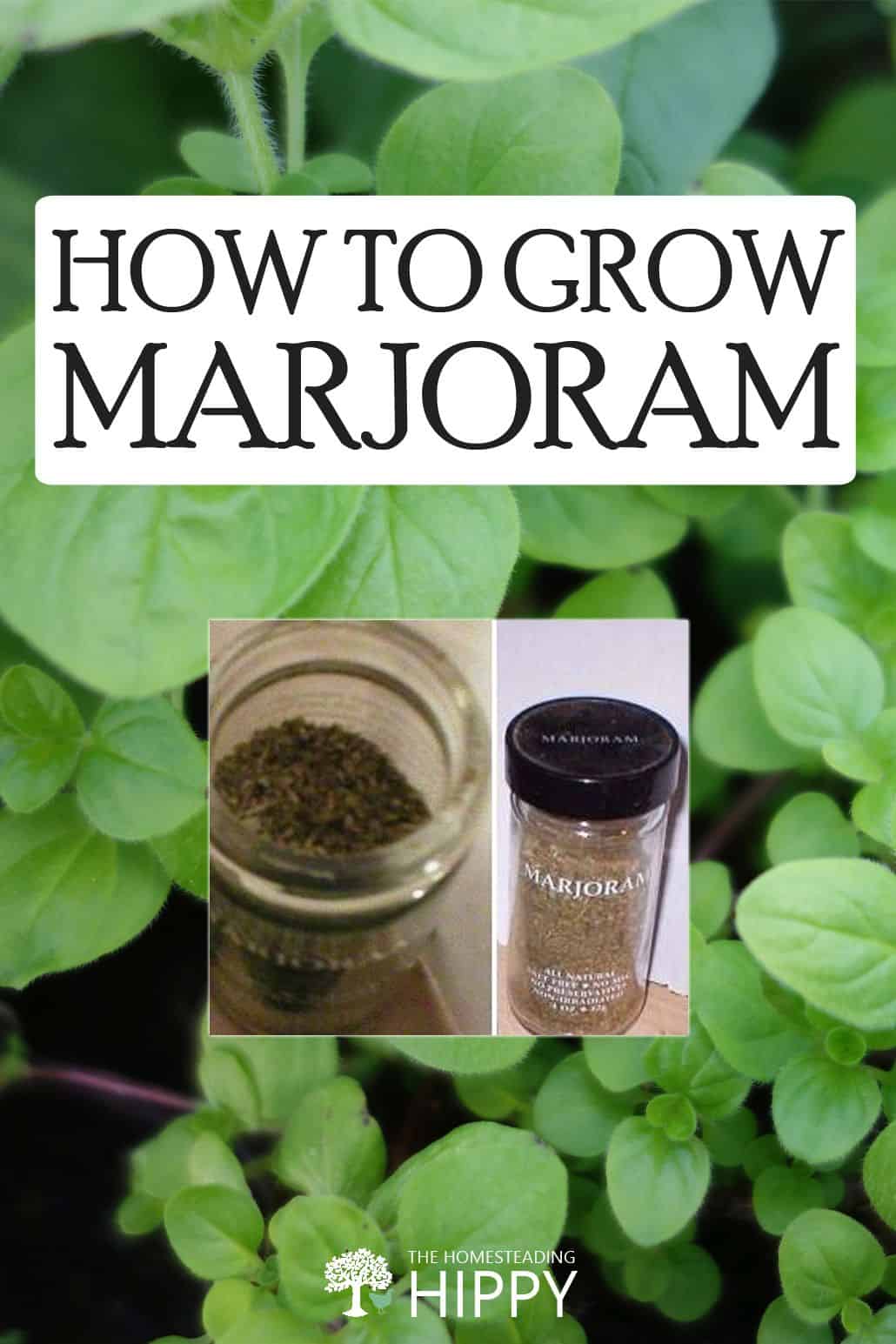Growing marjoram is a great way to add flavor and variety to both your kitchen and your herb garden.
It’s actually not a difficult plant to grow as long as you pay attention to the weather. My fatal downfall was that I put my plants outside too soon – and we got a late-season snowstorm.
As long as you pay attention to the weather and a few specific growing requirements, learning how to grow marjoram is not too difficult to do. Here are some tips that I’ve learned along the way.
Why You Should Grow Marjoram
There are lots of reasons to grow marjoram in a garden. Not only does this herb have a variety of uses in the kitchen, but the plants are also known to attract butterflies and other pollinators and beneficial insects to the garden. In fact, marjoram plants are excellent companion species for other plant types.
Marjoram is most easily recognized as a common cooking spice, but you can also make herbal medicines from marjoram’s leaves, oil, and flowers.
The plants can be used to treat runny noses, colds, and other respiratory symptoms. It can heal certain digestion problems, too, like poor appetite and stomach cramps. It’s often served as tea.
Marjoram also has powerful anti-inflammatory and antioxidant properties, too. It is antimicrobial as well.
As a culinary spice, marjoram can add a ton of flavor to your meals. It has a flavor that’s similar to oregano, but much milder. It can be used in meat dishes, soups, and salads.
It’s more potent when dried but can also be used fresh. It’s rich in vitamin C along with vitamin A, phosphorus, magnesium, potassium, and calcium, too.
Don’t confuse it with oregano though! Marjoram is often referred to as wild oregano, but the two plants are not one and the same.
Types of Marjoram
There are three main types of marjoram – knotted or sweet marjoram (Origanum majorana), pot marjoram (Origanum onites) and wild marjoram, also known as wild oregano or Origanum vulgare.
Sweet marjoram is the most common type of marjoram that we use in the kitchen, but all of these marjoram types are closely related to mint – they are in the same family.
Planting Marjoram from Seed
You can sow marjoram seeds directly in the garden. This is best for gardeners who have a long growing season – if you live in a warm growing zone, you may be able to grow marjoram as a perennial. Those who live in colder zones will have to grow it as an annual, in which case it’s usually best to start seeds indoors.
You will want to start seeds well after the last frost. The soil should be warm, around 70 degrees Fahrenheit (21 Celsius). Seedlings will take up to 21 days to emerge.
Before sowing your seeds, make sure you remove all weeds and work some organic matter into the soil. Ideally, this should be done to a depth of about seven inches.
Sow your seeds evenly and cover with ¼ inch of fine soil. Firm the soil and keep it moist. Full sunlight is recommended for sowing seeds as well as for transplanting marjoram plants later on.
Transplanting Marjoram
If you are starting marjoram seeds indoors, do so about eight to ten weeks before the last frost. Sow your seeds ¼ of an inch deep in a nutrient-rich seed starting formula.
Keep your soil moist and warm. If you can, use a heat mat to speed up germination. Your seedlings will emerge in two to three weeks.
You don’t need much light prior to germination, but once seedlings appear, make sure you provide plenty of light.
LED grow lights work well for this purpose, ideally turned on for sixteen hours each day and off for eight hours at night. As your plants grow taller, you will need to raise the lights.
Don’t leave the lights on for 24 hours. Not only can this make the plants get too hot, but plants do need some dark periods for their growth, too.
If you are growing your plants in small planting cells, you might need to replant to four-inch pots when the plants have three pairs of leaves. This will provide them with plenty of room to develop strong roots before you transplant them outside.
Once your plants are growing strong and vigorously – and the weather has warmed outside – you can begin the process of hardening off your plants. To do this, move your plants to a sheltered place outside for just one week. Protect your plants from the wind and hot sun.
If frost threatens, bring your plants inside. The process of hardening off your plants will toughen up the plant cell structure, and may reduce undesirable symptoms like sunscald and transplant shock
To transplant your marjoram plants, select a location that is sunny and has well-draining, somewhat acidic soil. Don’t transplant until your plants have a minimum of two pairs of leaves (three is better).
When you transplant, dig a hole that is large enough to accommodate the root ball of the plant, with some space left over.
Gently remove your plant from its pot and loosen the roots with your hands. Place the very top of the root ball level with the soil, then backfill with soil to the top of the root ball. Press down firmly.
After planting, water thoroughly and apply some mulch to reduce weed competition, and converse water.

How to Grow and Care for Marjoram
Watering
Keep your marjoram plants well-watered during the growing season, especially when they are first becoming established. You will need to provide at least one inch of rain during the growing season – potentially more during dry spells.
To figure out whether you need to water, use a rain gauge. This will tell you whether you need to add water. The best way to water marjoram plants is with a drip irrigation system that will deliver water at a very low pressure exactly where your plants need it – at the soil level.
The best time to water marjoram plants is first thing in the morning. This will give your plants plenty of time to dry out before nightfall – you’ll have a reduced likelihood of disease.
Weeding
When growing marjoram, it’s important that you are proactive in controlling weeds. Small herbs like marjoram can quickly be overcome by larger, more vigorously growing weeds.
Weeds are detrimental in several ways. They block out light, and they can also compete for space, nutrients, and water. To get rid of weeds, cultivate or hand-pull often – or use a mulch to prevent weed seeds from germinating.
Using an organic mulch is smart because it can also help to retain soil moisture, and maintain even soil temperatures.
For herbs, the best mulches are those made out of materials like aged bark and shredded leaves. Just make sure you keep mulch away from the stems of a plant to prevent rot.
Fertilizing
As seedlings, your marjoram plants don’t need much fertilizer. yOu can feed your plants when they are three to four weeks old by using a starter solution that is half the strength of regular plant food.
Even more important than fertilizing is encouraging the upright, bushy growth of your plants. You can do this by pinching the stems occasionally.
Pests and Diseases
Marjoram is a relatively disease-free plant, as are most herbs. However, there are some you will want to watch out for.
Botrytis blight, also known as gray mold, causes a fungus to appear on the stems and leaves of your plant. The leaves can then die back and fall off. It can cause the entire plant to die if the infection is severe. To prevent it, you will want to remove any infected plants and clean your tools before working to limit the spread of disease.
Damping-off is another common disease – this one is not exclusive to marjoram but can be found in all kinds of plants. It is most common when you are starting plants from seed. At first, the emerging seedling will appear healthy – but then it will suddenly wilt and die.
This disease is caused by a fungus. To prevent it, you should watch your watering. Usually, damping-off is caused by too-wet soil that encourages the growth of fungus. Keep your seedlings moist but don’t overwater them, and thin them out occasionally to make sure they aren’t overcrowded.
Other diseases to watch out for include rust, powdery mildew, and downy mildew. These can be controlled with proper watering, adequate air circulation, and good crop rotation.
When it comes to pests, aphids are the primary offenders. These insects spread disease as they feed on the underbellies of plants.
They can also leave behind a sticky residue that attracts ants. Encourage natural predators in your garden and use an insecticidal soap if your infestation is severe.
You should also watch out for cutworms, mealybugs, and spider mites. The best line of defense against these pests is by growing healthy, strong plants – they will be much more resistant to disease.
Companion Plants
Marjoram is an excellent companion plant for many species. This delicate herb doesn’t have many bad neighbors. Instead, it grows well next to most plants and can sometimes stimulate the growth of its neighbors, too.
It is also attractive to bees and other pollinators, so growing marjoram is a great way to improve the overall health and production of your entire garden.
Some plants that grow particularly well when paired with marjoram include celery,e eggplant, peas, radishes, potatoes, onions, and corn.
Growing Marjoram in a Container
Don’t have space in your garden for marjoram? Don’t worry. You can also grow it in a container.
To do this, you will want to choose a container that is at least six inches wide and has plenty of holes at the bottom for drainage. Choose a container that is equally deep, about six to eight inches.
Marjoram grows relatively slowly, but once it outgrows its container, you can always transplant it to another, larger one.
Growing Marjoram Indoors
Marjoram can also be grown indoors. Since the plant is relatively drought-tolerant, it’s one of the bed herbs you can grow indoors if you are new to herb gardening.
Just stash your plant in a sunny windowsill and make sure it gets plenty of air circulation. You may need to fertilize occasionally, too.
Harvesting Marjoram
Marjoram is generally ready to harvest after about 60 days following sowing. You can do this by snipping off leaves with a basic pair of scissors or garden pruners.
Just cut leaves as you need them, ideally once the plant is at least six inches tall. You’ll find that the flavor intensifies as the weather grows hotter.
Don’t be afraid to harvest frequently, either. The more often you harvest, the more often the plant will renew itself.
Just make sure you harvest before the plant flowers to ensure the best taste. By removing the plant’s flowers, you can extend the harvest time of your plant.
Preserving Marjoram
Store your marjoram in the refrigerator, ideally wrapped in damp paper towels and then placed in a plastic bag. Store it in the lower parts of the fridge, where it should keep for several days.
You can dry your marjoram leaves in the refrigerator by spreading them on a baking sheet and covering them with a paper towel. You can also do this in an uncovered bowl. Just stir them every day and they should dry in about three to seven days.

You can also dry marjoram leaves by using a mesh bag and hanging them in a warm, shaded, and dry location. Using a dehydrator will also work, and sometimes, you may be able to freeze marjoram in oil to use it directly in your cooking later on.
Once your marjoram leaves are dried, though, make sure you store them in an airtight container so they hold onto their flavor.
Uses for Marjoram
You can use marjoram both fresh and dried. In fact, marjoram, when compared to other herbs, dries particularly well. When you’re selecting marjoram to use in your cooking, always look for herbs that are fresh and healthy-looking, particularly those without blemishes or discoloration.
Marjoram has a delicate, somewhat sweet flavor that enables it to pair well with a variety of types of foods. Usually, it’s paired with meats like lamb, beef, veal, pork, and chicken, but it can also be paired with seafood and vegetables, too.
Some suggestions? Use marjoram on your favorite pizza, or in sausages or meatballs. You can sprinkle some over a fresh salad, or even add it to a stuffing mixture.
There are countless options for ways you can use marjoram in your cooking – be creative! You’re sure to love them all.
Should I Grow Marjoram?
There are hundreds of ways you can cook with marjoram – so it’s definitely worth growing in your garden. Marjoram likes to be warm but tolerates dry weather well, making it a good candidate for places in the garden where other plants fail to thrive.
Consider growing a few plants yourself, and follow these tips – you’ll probably be much more successful than I was in my first go-around!


Rebekah is a full-time homesteader. On her 22 acres, she raises chickens, sheep, and bees, not to mention she grows a wide variety of veggies. She has a huge greenhouse and does lots of DIY projects with her husband in her ever-growing homesteading endeavor. Learn more about Rebekah here.
